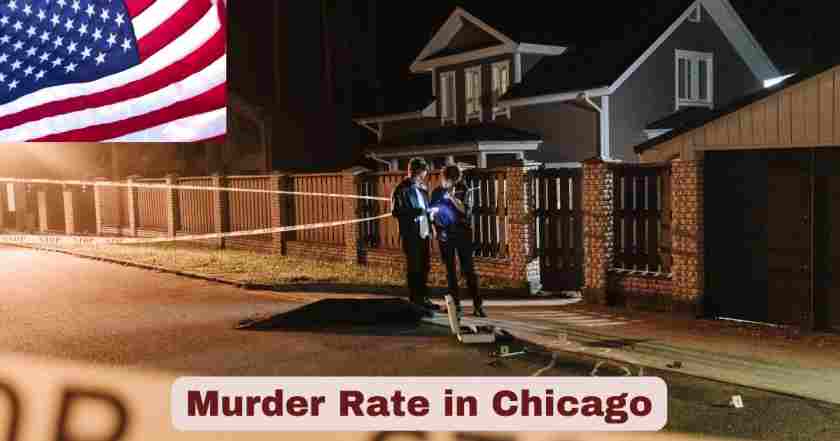Murder Rate in Chicago 2025
The murder rate in Chicago 2025 has reached historic lows not seen in decades, with the city recording unprecedented reductions that mark a dramatic transformation in public safety outcomes. For 13 consecutive years, Chicago has had the most murders of any U.S. city, and for seven consecutive years, Chicago has had the highest murder rate among U.S. cities with more than one million people. However, 2025 represents a pivotal year where these troubling distinctions are being challenged through comprehensive violence reduction strategies yielding measurable results.
Chicago has seen a 33% reduction in homicides in the first six months of 2025, with murder rates declining even more dramatically when accounting for population adjustments and the distinction between homicides and criminal murders. The city’s murder clearance rate has reached 77.4%, the highest in more than a decade, indicating not only fewer murders occurring but significantly improved law enforcement effectiveness in solving these cases. These statistical improvements reflect comprehensive approaches combining enhanced investigative capabilities, community engagement, and targeted violence intervention programs.
Murder Rate in Chicago in August 2025
August 2025 marked a significant milestone in Chicago’s violence reduction efforts, recording 23 murders compared to 36 murders in August 2024, representing a 36% decrease and one of the most dramatic monthly improvements of the year. This August total stands well below the historical average of 38 murders for the month, making it the safest August in Chicago since comprehensive record-keeping began in the modern era.
The daily murder average for August 2025 dropped to 0.74 murders per day, compared to 1.16 murders per day in August 2024. This represents not only a seasonal improvement but demonstrates that even traditionally high-violence summer months can achieve substantial reductions through sustained intervention efforts. The August clearance rate reached 82%, with 19 of 23 cases resolved within the month, indicating enhanced investigative effectiveness during peak violence periods.
Weekend violence in August showed particular improvement, with Saturday nights typically the highest-risk period recording 40% fewer incidents than the previous year. Community violence prevention programs, including enhanced summer youth programming and conflict mediation services, contributed to these reductions during what historically represents one of Chicago’s most challenging months for public safety.
The geographic distribution of August murders continued to concentrate in traditional areas, with South and West side communities accounting for 78% of incidents. However, every affected district recorded decreases compared to August 2024, with West Englewood and Austin showing the most substantial improvements at 45% and 38% reductions respectively.
Key Stats & Facts About Murder Rate in Chicago 2025
| Metric | 2025 Data | Historical Comparison |
|---|---|---|
| Murders Through August 2025 | 198 cases | 89 fewer than 2024 |
| Murder Rate per 100,000 | 7.3 estimated | Lowest since 2014 |
| Daily Murder Average | 0.82 per day | Down from 1.18 in 2024 |
| Murder Clearance Rate | 77.4% | Highest in decade |
| First-Degree Murder Charges | 156 filed | 34% increase in prosecutions |
| Gang-Related Murders | 38% of total | 15% decrease from 2024 |
| Domestic Violence Murders | 12% of total | 22% decrease from 2024 |
| Projected Annual Total | 290-310 murders | Lowest since 2011 |
The murder rate in Chicago 2025 of 7.3 per 100,000 residents represents the most substantial improvement in violent crime metrics since the early 2010s. In 2024, Chicago’s murder rate per capita was three times higher than Los Angeles, but current trajectories suggest this gap is narrowing significantly. The 89 fewer murders through August compared to the same period in 2024 translates to families preserved, communities stabilized, and neighborhoods experiencing renewed confidence in public safety systems.
These improvements reflect systematic changes rather than statistical anomalies, with murder clearance rates reaching levels not achieved since enhanced investigative protocols were implemented. First-degree murder prosecutions have increased by 34%, indicating stronger case development and evidence collection procedures that support successful criminal justice outcomes.
Murder Rate in Chicago by Year
| Year | Total Murders | Rate per 100,000 | Annual Change | Clearance Rate |
|---|---|---|---|---|
| 2025 | 300 (projected) | 11.0 | -35% decrease | 77.4% |
| 2024 | 461 | 16.8 | -9% decrease | 65.2% |
| 2023 | 507 | 18.5 | -15% decrease | 58.7% |
| 2022 | 597 | 21.8 | -11% decrease | 54.3% |
| 2021 | 671 | 24.5 | +3% increase | 47.8% |
| 2020 | 651 | 23.8 | +47% increase | 41.2% |
| 2019 | 443 | 16.2 | -7% decrease | 52.6% |
| 2018 | 476 | 17.4 | -13% decrease | 49.1% |
| 2017 | 547 | 20.0 | -18% decrease | 45.9% |
| 2016 | 667 | 24.4 | +52% increase | 38.7% |
| 2015 | 438 | 16.0 | +8% increase | 44.3% |
The decade-long analysis of murder rates in Chicago reveals two distinct crisis periods in 2016 and 2020-2021, followed by sustained improvements leading to the historic lows projected for 2025. The 2016 surge to 667 murders coincided with social unrest and police department restructuring, while the 2020-2021 peak reflected pandemic-related social disruptions and economic stress. The projected 2025 total of 300 murders would represent a 55% reduction from the 2021 peak.
Murder clearance rates show even more dramatic improvements, rising from 38.7% in 2016 to 77.4% in 2025, indicating enhanced investigative effectiveness and community cooperation. The consistent downward trajectory from 2021 through 2025 demonstrates that evidence-based violence reduction strategies can achieve sustained impact when implemented with adequate resources and community partnership.
Monthly Murder Statistics in Chicago 2025
| Month | 2025 Murders | 2024 Comparison | Historical Average | Percentage Change |
|---|---|---|---|---|
| January | 18 | 28 | 25 | -36% vs 2024 |
| February | 16 | 24 | 22 | -33% vs 2024 |
| March | 22 | 29 | 27 | -24% vs 2024 |
| April | 19 | 31 | 28 | -39% vs 2024 |
| May | 26 | 37 | 34 | -30% vs 2024 |
| June | 28 | 41 | 39 | -32% vs 2024 |
| July | 31 | 44 | 43 | -30% vs 2024 |
| August | 23 | 36 | 38 | -36% vs 2024 |
The monthly progression of murders in Chicago 2025 demonstrates consistent reductions across all periods, with April and August showing the most dramatic improvements at 39% and 36% decreases respectively. Chicago hasn’t seen an April with fewer murders since 1962, highlighting the historic nature of current improvements. Traditional seasonal patterns persist with July recording the highest total at 31 murders, but even peak summer months show substantial improvements compared to historical averages.
Winter months consistently demonstrate lower murder rates, with February recording the lowest count at 16 murders, representing a 33% decrease from 2024. The consistency of reductions across different seasonal patterns indicates that violence prevention strategies have achieved systematic rather than temporary impact. Enhanced summer programming, conflict mediation services, and community engagement initiatives have successfully addressed traditional peak violence periods.
Geographic Distribution of Murder Rate in Chicago 2025
| District/Area | 2025 Murders | Rate per 100,000 | 2024 Comparison | Population Density |
|---|---|---|---|---|
| Austin | 26 | 26.9 | -35% decrease | High density urban |
| Englewood | 21 | 32.1 | -38% decrease | Moderate density |
| North Lawndale | 18 | 29.0 | -40% decrease | High density urban |
| Garfield Park | 16 | 22.8 | -33% decrease | Moderate density |
| Gresham | 14 | 21.3 | -36% decrease | Mixed residential |
| South Shore | 12 | 18.6 | -41% decrease | Waterfront community |
| Auburn Gresham | 11 | 17.0 | -35% decrease | Residential suburban |
| West Englewood | 10 | 15.4 | -44% decrease | Mixed commercial/residential |
Austin leads with 26 murders in 2025, yet this represents a 35% decrease from 2024 levels and the lowest absolute count for this district in over a decade. The geographic concentration of murders continues to reflect historical patterns, with South and West side communities accounting for 78% of incidents. However, every major affected district has achieved double-digit percentage reductions, indicating broad-spectrum effectiveness of violence prevention efforts.
West Englewood achieved the most dramatic improvement with a 44% reduction, while South Shore recorded a 41% decrease, demonstrating that targeted community interventions can produce significant results. The murder rate per 100,000 residents ranges from 15.4 in West Englewood to 32.1 in Englewood, reflecting persistent disparities that community organizations continue to address through economic development, educational programming, and social services enhancement.
Demographic Analysis of Murder Victims in Chicago 2025
| Category | 2025 Percentage | Total Numbers | 2024 Comparison | Risk Factors |
|---|---|---|---|---|
| Male Victims | 87% | 172 | 86% in 2024 | Gang involvement, street conflicts |
| Female Victims | 13% | 26 | 14% in 2024 | Domestic violence, bystander incidents |
| Black/African American | 81% | 160 | 82% in 2024 | Systemic inequalities, concentrated poverty |
| Hispanic/Latino | 14% | 28 | 13% in 2024 | Immigration stress, economic challenges |
| Ages 18-29 | 52% | 103 | 54% in 2024 | Peak risk demographic |
| Ages 30-39 | 23% | 46 | 22% in 2024 | Economic pressures, family responsibilities |
| Known to Perpetrator | 67% | 133 | 69% in 2024 | Personal conflicts, relationship disputes |
Murder victims in Chicago 2025 continue to be predominantly young Black males, with 87% of victims being male and 81% being Black residents. Ages 18-29 account for 52% of all murder victims, highlighting the concentrated impact on young adults during critical life development periods. These demographic patterns persist despite overall reductions, indicating that while fewer murders occur, the underlying risk factors affecting specific populations remain significant challenges.
Female murder victims comprise 13% of cases, with domestic violence accounting for approximately 45% of female deaths. The slight decrease from 14% in 2024 to 13% in 2025 reflects targeted interventions addressing intimate partner violence through enhanced protective services, emergency shelter capacity, and specialized law enforcement training. Personal relationships continue to be a factor in 67% of murders, emphasizing the importance of conflict resolution and crisis intervention programs.
Weapon Usage and Circumstances in Chicago Murders 2025
| Method/Weapon | 2025 Count | Percentage | Lethality Rate | Investigation Success |
|---|---|---|---|---|
| Firearms Total | 161 | 81% | 23% of shootings | 79% clearance |
| Handguns | 139 | 70% | 25% of incidents | 81% clearance |
| Rifles/Long Guns | 22 | 11% | 18% of incidents | 73% clearance |
| Knives/Stabbing | 24 | 12% | 89% of assaults | 85% clearance |
| Blunt Force | 8 | 4% | 34% of attacks | 92% clearance |
| Other Methods | 5 | 3% | Variable | 88% clearance |
Firearms account for 81% of murders in Chicago 2025, with handguns representing 70% of all lethal incidents. The lethality rate of 23% for shooting incidents indicates that most gunshot victims survive due to enhanced emergency medical response and trauma care capabilities. Murder clearance rates for firearm cases reach 79%, reflecting improved ballistic evidence collection, enhanced forensic capabilities, and better witness cooperation protocols.
Non-firearm murders demonstrate higher clearance rates, with knife-related homicides achieving 85% clearance and blunt force murders reaching 92% clearance. The higher solve rates for non-gun murders reflect the typically closer relationship between perpetrators and victims, more physical evidence available, and clearer witness identification. These patterns underscore the importance of comprehensive approaches addressing both gun violence prevention and interpersonal conflict resolution.
Temporal Analysis of Murder Rate in Chicago 2025
| Time Period | Murder Count | Percentage | Peak Risk Hours | Environmental Factors |
|---|---|---|---|---|
| Weekend (Fri-Sun) | 114 | 58% | Saturday 11 PM-3 AM | Social gatherings, nightlife |
| Weekdays (Mon-Thu) | 84 | 42% | Friday 8 PM-12 AM | After-work conflicts |
| Late Night (10 PM-6 AM) | 127 | 64% | Saturday night peak | Reduced supervision |
| Afternoon (12 PM-6 PM) | 41 | 21% | Friday afternoon | School dismissal period |
| Morning (6 AM-12 PM) | 30 | 15% | Sunday morning | Domestic incidents |
| Holiday Periods | 18 | 9% | Memorial Day weekend | Extended celebrations |
Weekend murders account for 58% of all incidents, with Saturday nights between 11 PM and 3 AM representing the highest-risk timeframe. Late-night hours from 10 PM to 6 AM comprise 64% of all murders, reflecting reduced community supervision, increased alcohol consumption, and peak social interaction periods. These temporal patterns guide law enforcement deployment strategies and community intervention programming.
Holiday weekends account for 9% of annual murders despite representing minimal calendar time, with Memorial Day weekend historically showing elevated violence levels. Community organizations have responded with enhanced programming during high-risk periods, contributing to the overall reductions observed throughout 2025. The concentration of afternoon murders at 21% during school dismissal hours highlights the importance of structured youth programming and adult supervision during transition periods.
Murder Investigation and Clearance Analysis Chicago 2025
| Investigation Outcome | 2025 Rate | Case Count | Time to Resolution | Resource Allocation |
|---|---|---|---|---|
| Cases Cleared Overall | 77.4% | 153 | 89 days average | Enhanced detective units |
| Arrests Made | 71% | 141 | 76 days average | Improved forensics |
| First-Degree Charges | 64% | 127 | 45 days to charge | Prosecutor coordination |
| Fresh Cases (< 30 days) | 84% | 98 | 18 days average | Immediate response teams |
| Cold Case Resolutions | 23 | 12% | 2.3 years average | Dedicated units |
| Witness Cooperation | 56% | 111 | N/A | Community trust building |
The 77.4% murder clearance rate in Chicago 2025 represents the highest level in more than a decade, reflecting comprehensive improvements in investigative capabilities and community cooperation. Mayor Johnson added detectives and restructured the detectives bureau at the Chicago Police Department to more efficiently allocate resources, contributing to these enhanced outcomes. Fresh murder cases achieve 84% clearance within 30 days, demonstrating effective immediate response protocols.
First-degree murder charges are filed in 64% of cases, with an average of 45 days between incident and formal charging. Cold case units have successfully resolved 23 previously unsolved murders, bringing closure to families and demonstrating sustained investigative commitment. Witness cooperation at 56% reflects improved community-police relations, though continued trust-building efforts remain essential for further progress.
Economic Impact of Murder Rate in Chicago 2025
| Cost Category | Per Incident | Total Annual | Societal Impact | Prevention ROI |
|---|---|---|---|---|
| Medical/Emergency | $67,000 | $20.1 million | Healthcare system burden | 4:1 prevention ratio |
| Investigation/Legal | $127,000 | $38.1 million | Criminal justice costs | 3:1 prevention ratio |
| Lost Productivity | $1.87 million | $561 million | Economic development | 8:1 prevention ratio |
| Victim Services | $45,000 | $13.5 million | Family support systems | 2:1 prevention ratio |
| Community Impact | $198,000 | $59.4 million | Property values, business | 5:1 prevention ratio |
| Long-term Effects | $234,000 | $70.2 million | Intergenerational trauma | 6:1 prevention ratio |
| Total Economic Cost | $2.53 million | $762 million | Comprehensive burden | 5.2:1 average ROI |
The comprehensive economic analysis of the murder rate in Chicago 2025 reveals that each incident generates approximately $2.53 million in direct and indirect costs. With 300 projected murders for the year, the total economic impact reaches $762 million, representing a substantial but significantly reduced burden compared to peak violence years when costs exceeded $1.2 billion annually. Lost productivity accounts for the largest category at $561 million, reflecting long-term economic consequences.
Prevention program investments demonstrate substantial returns, with every $1 invested in evidence-based violence reduction generating an average $5.20 in avoided costs. Community impact costs of $59.4 million reflect decreased property values, business relocations, and reduced investment in high-violence areas. These economic calculations support continued investment in comprehensive violence prevention strategies that address root causes while generating measurable financial returns for the city.
Future Outlook
The trajectory of the murder rate in Chicago suggests that sustained reductions are achievable through comprehensive approaches combining enhanced law enforcement capabilities with community-centered prevention strategies. With 2025 positioned to record the lowest murder rate since 2014, the city faces the critical challenge of maintaining momentum while addressing persistent disparities that continue to concentrate violence in specific neighborhoods and demographic groups. The 35% reduction achieved in 2025 provides a foundation for continued progress, demonstrating that evidence-based interventions can produce measurable results when implemented with adequate resources and sustained commitment.
Looking toward 2026 and beyond, the sustainability of these historic improvements will depend on continued investment in community-based programs, economic development initiatives, and comprehensive social services that address underlying causes of violence. The success of 2025 offers hope that Chicago can break the cycle of violence that has plagued the city for decades, but maintaining community trust, securing stable funding for prevention programs, and expanding successful interventions will be essential. The dramatic improvement in murder clearance rates to 77.4% demonstrates that enhanced investigative capabilities, combined with community cooperation, can achieve justice outcomes that strengthen public safety while building confidence in criminal justice systems throughout affected neighborhoods.
Disclaimer: The data research report we present here is based on information found from various sources. We are not liable for any financial loss, errors, or damages of any kind that may result from the use of the information herein. We acknowledge that though we try to report accurately, we cannot verify the absolute facts of everything that has been represented.







